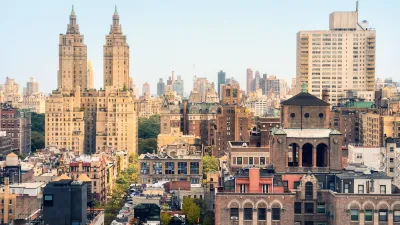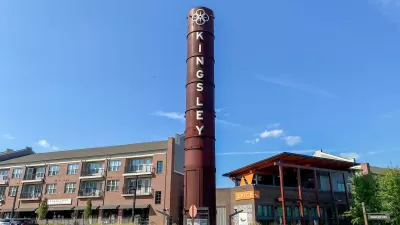With more and more employers downsizing and moving to areas with more urban amenities, large suburban office parks offer an opportunity for increased density and mixed-use development.

Writing in The New York Times, Emily Badger describes the plight of a fading American typology: the suburban office park. “Today suburban office parks have drawn far less attention than downtown offices that are also threatened by remote work. But their decline reflects in some ways a more sweeping and permanent judgment — of once-dominant ideas about where Americans work, how the office should look, and what the suburbs should be.”
According to Badger, “Far from downtowns, there is a different kind of emptiness in suburban settings that were already isolated and lightly populated by design.” While some office parks will likely be modernized and used as offices again, “Other sites will have to become something fundamentally different: schools, senior living centers, apartment complexes, public parks, warehouses.” According to an estimate by commercial real estate firm Jones Lang LaSalle, “57 percent of suburban office space nationwide is so old as to be functionally obsolete.”
However, their massive footprints offer the opportunity for redevelopment with a variety of uses and amenities. “Amid a nationwide housing crisis, many obsolete office parks could be ideal sites for denser housing.” As Badger points out, “Multifamily housing is expensive to build, but the land now being used for suburban parking lots is cheap, so the economics can work out (if the politics do).” To this end, cities and counties must be open to zoning reforms that allow for adaptive reuse of office parks and promote mixed-use development on these sites.
FULL STORY: Lonely Last Days in the Suburban Office Park

Study: Maui’s Plan to Convert Vacation Rentals to Long-Term Housing Could Cause Nearly $1 Billion Economic Loss
The plan would reduce visitor accommodation by 25,% resulting in 1,900 jobs lost.

North Texas Transit Leaders Tout Benefits of TOD for Growing Region
At a summit focused on transit-oriented development, policymakers discussed how North Texas’ expanded light rail system can serve as a tool for economic growth.

Why Should We Subsidize Public Transportation?
Many public transit agencies face financial stress due to rising costs, declining fare revenue, and declining subsidies. Transit advocates must provide a strong business case for increasing public transit funding.

How to Make US Trains Faster
Changes to boarding platforms and a switch to electric trains could improve U.S. passenger rail service without the added cost of high-speed rail.

Columbia’s Revitalized ‘Loop’ Is a Hub for Local Entrepreneurs
A focus on small businesses is helping a commercial corridor in Columbia, Missouri thrive.

Invasive Insect Threatens Minnesota’s Ash Forests
The Emerald Ash Borer is a rapidly spreading invasive pest threatening Minnesota’s ash trees, and homeowners are encouraged to plant diverse replacement species, avoid moving ash firewood, and monitor for signs of infestation.
Urban Design for Planners 1: Software Tools
This six-course series explores essential urban design concepts using open source software and equips planners with the tools they need to participate fully in the urban design process.
Planning for Universal Design
Learn the tools for implementing Universal Design in planning regulations.
City of Santa Clarita
Ascent Environmental
Institute for Housing and Urban Development Studies (IHS)
City of Grandview
Harvard GSD Executive Education
Toledo-Lucas County Plan Commissions
Salt Lake City
NYU Wagner Graduate School of Public Service





























